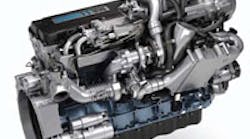Componenta Dktas, a Turkish metalcasting operation, is increasing its commercial production of compacted graphite iron components, namely cylinder block and heads for the new heavy-duty diesel engine recently launched by Turkey’s top commercial vehicle manufacturer, Ford-Otosan.
Both the cylinder block and head of the new heavyduty diesel engine are produced in CGI at the Componenta Dktas foundry using high-volume process control technology supplied by SinterCast AB (www.sintercast.com). Componenta Dktas specializes in cast iron and aluminum castings for the automotive, agricultural, and off-road industries, and has grown to become the largest iron and aluminum foundry (diecasting, gravity, low pressure) in Turkey, and the sixth largest foundry in Europe. Componenta, its parent company, is headquartered in Finland, with operations in Scandinavia, The Netherlands, and Turkey, employing over 5,000 people.
Large-bore diesel engines
As a result of the strength, dimensional stability, and wear resistance of CGI – plus advanced design features incorporated by Ford-Otosan – the 9.0-liter engine becomes the largest parent bore (linerless) engine available in the heavy-duty diesel market. Plans are in place for this engine design to be followed by a new 7.3-liter Ecotorq engine later this year, and the cylinder block and head of the 7.3-liter engine also will be produced at Componenta Dktas, using the SinterCast process technology.
Late last year Componenta Dktas also started series production of a new CGI component known as a torsion damper, a transmission part that reduces torsional vibration from the crankshaft. Supplied by C.F. Gomma, one of Europe’s largest automotive suppliers, and with a weight of just 2.1 kg, the torsion damper becomes the smallest and lightest component yet produced using SinterCast technology.
Following a joint-development program among C.F. Gomma, Componenta Dktas, Grainger & Worrall, and SinterCast, C. F. Gomma specified Sinter- Cast-CGI for the series production due to favorable castability, machinability, and heat-transfer capabilities compared to ductile iron. The torsion damper is incorporated into transmission assemblies produced by C. F. Gomma and ultimately installed in OEM vehicles in European. Initial volumes are approximately 400,000 pieces per year, with future growth opportunities.
Seyfi Degirmenci, product development manager at Componenta Dktas, said: “Following the successful product development and validation period, we are pleased that these SinterCast-CGI components have now entered the market. We look forward to the start of production of the new 7.3-liter CGI cylinder block and head, and to benefiting from these CGI series production references as a platform to secure future CGI production opportunities.”
Dr. Steve Dawson, president and CEO of SinterCast AB, said: “We congratulate our partners on the successful development and sales launch of these new CGI products. We look forward to supporting the CGI series production activities of Componenta Dktas as their current CGI production reaches the planned mature volume of approximately 75,000 engine equivalents, and as additional SinterCast-CGI components are brought on-stream.”
Production progress
With at least 75% higher tensile strength, 45% higher stiffness, and approximately double the fatigue strength of conventional cast gray iron and aluminum, CGI allows engine designers to improve performance, fuel economy, and durability, while reducing engine size weight, noise, and emissions.
Foundries using SinterCast technology produce a variety of CGI components, ranging from 8 kg to 17 metric tons, all using the same process control technology. The latest list of end-users of SinterCast CGI components includes Aston Martin, Audi, Caterpillar, Chrysler, Ford, General Electric Transportation Systems, General Motors, Hyundai, International Truck and Engine, Jaguar, Kia, Land Rover, MAN, MAN B&W Diesel, PSA Peugeot-Citron, Rolls-Royce Power Engineering, Toyota, Volkswagen, Volvo, and Waukesha Engine.
Earlier this year, Tupy Casting, the metalcasting division of the Brazilian engine manufacturer, revealed plans to increase production capacity for CGI engine blocks by nearly 25%, from 300,000 to 370,000 metric tons/ year. Among Tupy’s current CGI offerings are blocks for two Navistar International large-bore engines, the MaxxForce 11 and MaxxForce 13. They are produced at Tupy’s Mau foundry in S©o Paolo. The same operation produces heavy-duty diesel engine blocks for German truck builder MAN AG.
Most of the new, $220-million investment will go to increase production of CGI components. Tupy also plans to increase output of connecting rods and camshafts. The total output is expected to rise from 480,000 to 670,000 tons by 2010.
Luiz Tarqunio Sardine, president of Tupy’s ironmaking division, indicated the company’s expansion is in anticipation of greater demand for CGI blocks from General Motors, which is expanding engine production in Brazil. He explained that the new capacity will consist of two new casting lines, but that the investment program will include modernizations and new equipment installations, as well as improve operational efficiency and environmental controls.
One example of new long-term commitments to CGI comes from GM’s Cadillac division, which later this year will begin offering a 2.9-liter V6 turbo diesel engine in its 2009 CTS sedan for sales in Europe. The engine block for the new, compact V-6 diesel is made of CGI. The engine features a 60° bank angle, 83.0-mm bore, and 90.4-mm stroke, which results in displacement of 2,935 mm3. It produces 250 hp and 406 ft-lb of torque starting at 2,000 rpm.
The engine uses a new closed-loop control technology that GM describes as a breakthrough in diesel combustion management — a clean-diesel engine that’s expected to meet European standards through 2012.
GM is partnered with Italian engine builder VM Motori, a DaimlerChrysler subsidiary, on the project. VM Motori designed the base engine and will build the new unit in Cento, Italy. GM Powertrain developed the clean-combustion process, electronic engine control, and exhaust gas after-treatment.










